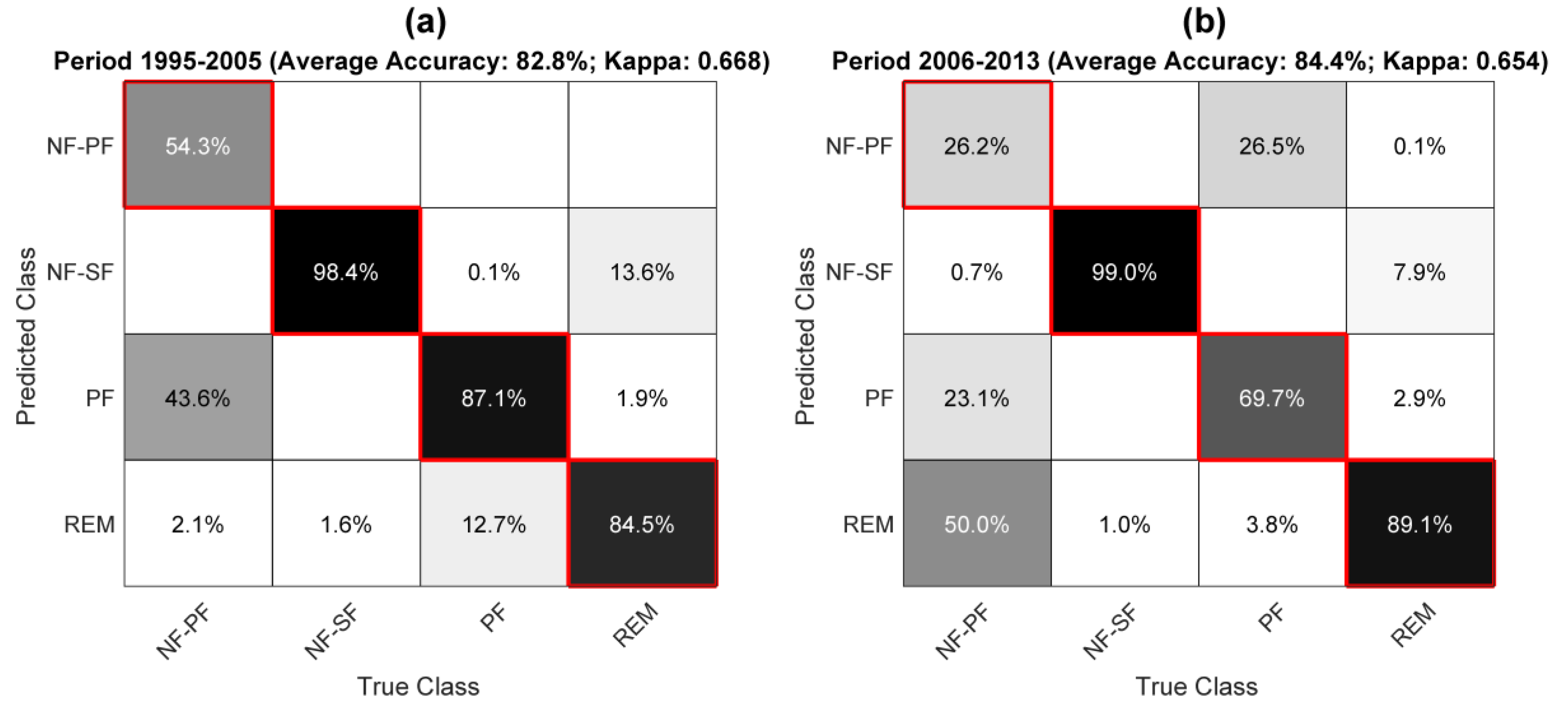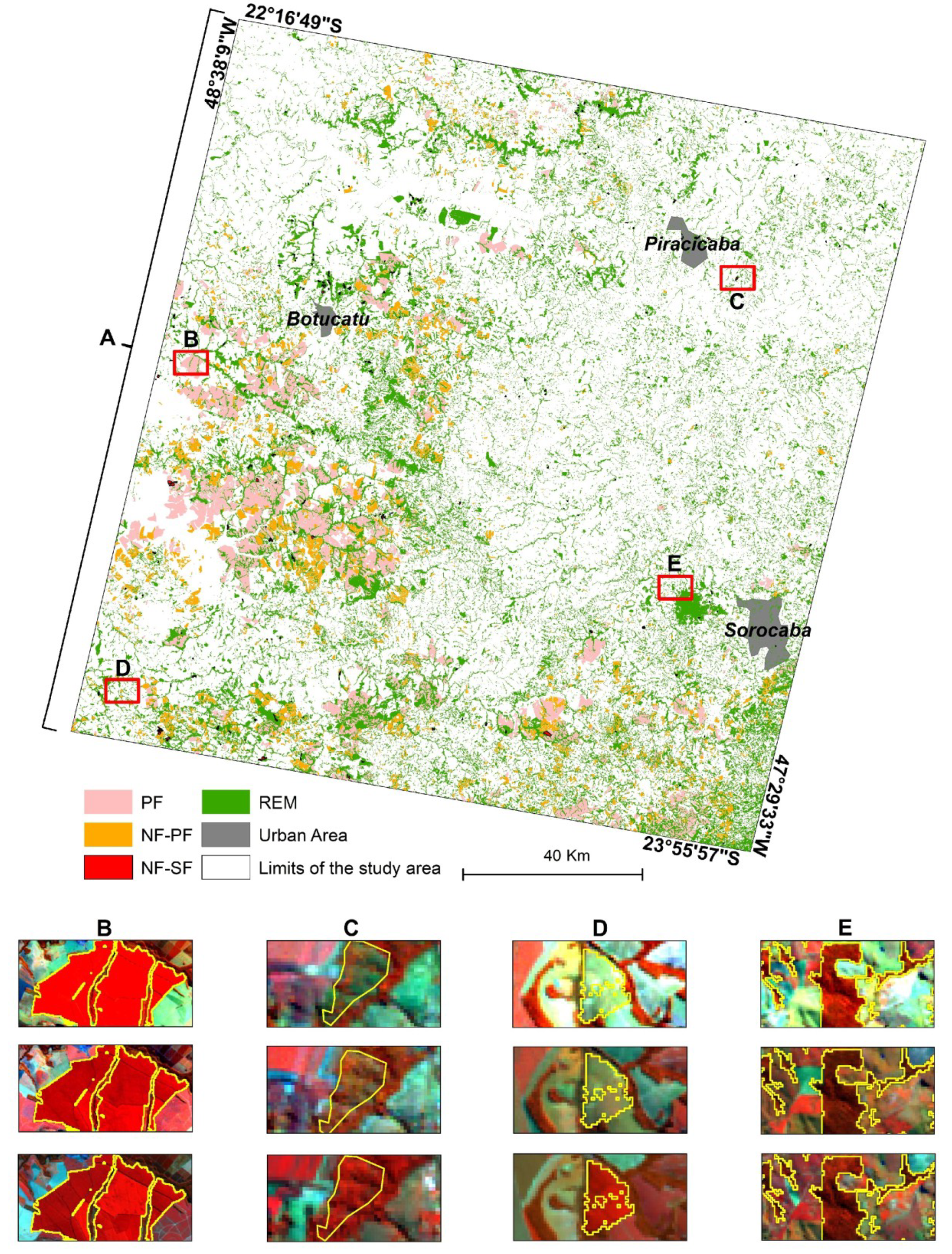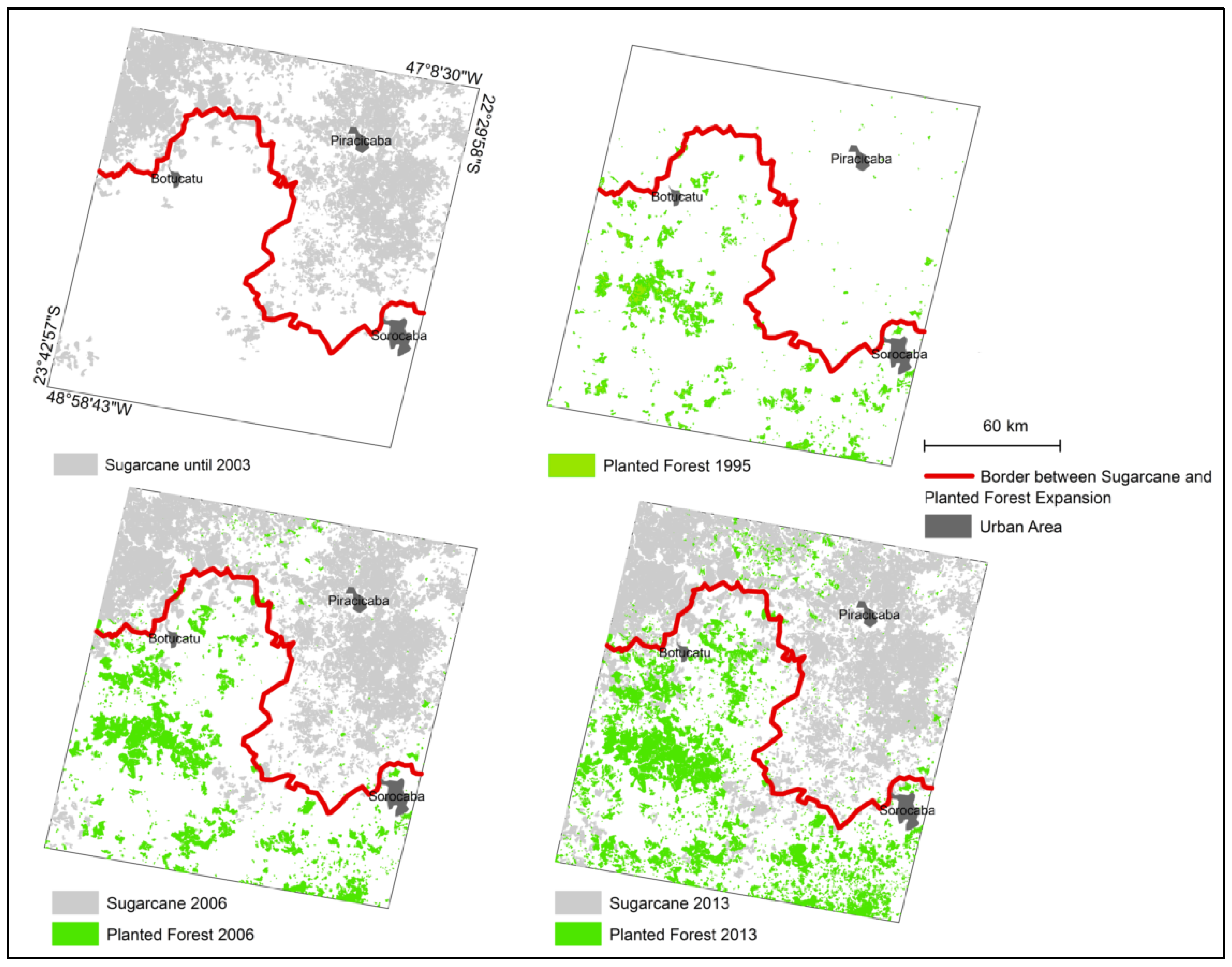Landsat-Based Land Use Change Assessment in the Brazilian Atlantic Forest: Forest Transition and Sugarcane Expansion
Abstract
:1. Introduction
2. Materials and Methods
2.1. Study Area
2.2. Materials
2.2.1. Landsat Images
2.2.2. Census Data
2.2.3. Ancillary Data
2.3. Methods
2.3.1. Production of the Forest Transition Map
2.3.2. Census Analysis
2.3.3. Calculation of Landscape Metric Indices
3. Results
3.1. Changes in Forest Cover in the Period of Study
3.2. Landscape Metrics and Isolation of Patches
3.3. Forest Transition and Land Use Changes
4. Discussion
5. Conclusions
Author Contributions
Acknowledgments
Conflicts of Interest
Appendix A


References
- Geist, H.J.; Lambin, E.F. What Drives Tropical Deforestation; LUCC Report Series; LUCC International Project Office, Department of Geography, University of Louvain: Leuven, Belgium, 2001; Volume 4, 116p. [Google Scholar]
- Lambin, E.F.; Turner, B.L.; Geist, H.J.; Agbola, S.B.; Angelsen, A.; Bruce, J.W.; George, P. The causes of land-use and land-cover change: Moving beyond the myths. Glob. Environ. Chang. 2001, 11, 261–269. [Google Scholar] [CrossRef]
- Walker, R.; Solecki, W. Theorizing Land-Cover and Land-Use Change: The Case of the Florida Everglades and Its Degradation. Ann. Assoc. Am. Geogr. 2004, 94, 311–328. [Google Scholar] [CrossRef]
- Machado, L. A Fronteira Agrícola na Amazônia Brasileira; Revista Brasileira de Geografia Rio de Janeiro: São Paulo, Brazil, 1992; Volume 54, pp. 1–120. [Google Scholar]
- Holanda, S.B.; Eulálio, A.; Ribeiro, L.G. Raízes do Brasil; Companhia das Letras: São Paulo, Brazil, 1995. [Google Scholar]
- Moraes, A.C.R. Bases da formação territorial do Brasil. Geografares 2001, 2, 105–113. [Google Scholar] [CrossRef]
- Becker, B.K. Geopolítica da Amazônia. Estudos Avançados 2005, 19, 71–86. [Google Scholar] [CrossRef]
- Alves, D.S. Science and technology and sustainable development in Brazilian Amazon. In Stability of Tropical Rainforest Margins; Springer: Berlin/Heidelberg, Germany, 2007; pp. 491–510. [Google Scholar]
- Dean, W. With Broadax and Firebrand: The Destruction of the Brazilian Atlantic Forest; University of California Press: Oakland, CA, USA, 1997. [Google Scholar]
- SOS Atlantic Forest. Annual Report—2015. São Paulo. 2015. Available online: https://www.sosma.org.br/wp-content/uploads/2016/08/RA_SOSMA_2015-Web.pdf (accessed on 17 January 2017).
- Machado, L. Limites, Fronteiras e Redes. In Fronteiras e Espaço Global, 1st ed.; AGB: Porto Alegre, Brazil, 1998; pp. 41–49. [Google Scholar]
- IBGE. Instituto Brasileiro de Geografia e Estatística. Censo Agropecuário 1995/96. Census of Agriculture. 1995/96. Available online: http://www.sidra.ibge.gov.br/ (accessed on 8 February 2017).
- IBGE. Instituto Brasileiro de Geografia e Estatística. Censo Agropecuário 2006. Census of Agriculture; 2006. Available online: http://www.sidra.ibge.gov.br/ (accessed on 8 February 2017).
- Adami, M.; Rudorff, B.F.T.; Freitas, R.M.; Aguiar, D.A.; Sugawara, L.M.; Mello, M.P. Remote Sensing Time Series to Evaluate Direct Land Use Change of Recent Expanded Sugarcane Crop in Brazil. Sustainability 2012, 4, 574–585. [Google Scholar] [CrossRef] [Green Version]
- Camara, M.R.G.D.; Caldarelli, C.E. Expansão canavieira e o uso da terra no estado de São Paulo. Estudos Avançados 2016, 30, 93–116. [Google Scholar] [CrossRef]
- Ferreira, M.P.; Alves, D.S.; Shimabukuro, Y.E. Forest dynamics and land-use transitions in the Brazilian Atlantic Forest: The case of sugarcane expansion. Reg. Environ. Chang. 2015, 15, 365–377. [Google Scholar] [CrossRef]
- Lira, P.K.; Tambosi, L.R.; Ewers, R.M.; Metzger, J.P. Land-use and land-cover change in Atlantic Forest landscapes. For. Ecol. Manag. 2012, 278, 80–89. [Google Scholar] [CrossRef]
- Silva, R.F.B.; Batistella, M.; Moran, E.F. Drivers of land change: Human-environment interactions and the Atlantic forest transition in the Paraíba Valley, Brazil. Land Use Policy 2016, 58, 133–144. [Google Scholar] [CrossRef]
- Rudel, T.K.; Coomes, O.T.; Moran, E.; Achard, F.; Angelsen, A.; Xu, J.; Lambin, E. Forest transitions: Towards a global understanding of land use change. Glob. Environ. Chang. Part A 2005, 15, 23–31. [Google Scholar] [CrossRef]
- Finegan, B. Pattern and process in neotropical secondary rain forests: The first 100 years of succession. Trends Ecol. Evol. 1996, 11, 119–124. [Google Scholar] [CrossRef]
- Farinaci, J.S.; Ferreira, L.D.C.; Batistella, M. Forest transition and ecological modernization: Eucalyptus forestry beyond good and bad. Ambiente Soc. 2013, 16, 25–46. [Google Scholar] [CrossRef]
- Mather, A.S. The forest transition. Area 1992, 24, 367–379. [Google Scholar]
- Mather, A.S.; Needle, C.L. The forest transition: A theoretical basis. Area 1998, 30, 117–124. [Google Scholar] [CrossRef]
- Farinaci, J.S.; Batistella, M. Variação na cobertura vegetal nativa em São Paulo: Um panorama do conhecimento atual. Revista Árvore 2012, 36, 695–705. [Google Scholar] [CrossRef]
- Yeo, I.Y.; Huang, C. Revisiting the forest transition theory with historical records and geospatial data: A case study from Mississippi (USA). Land Use Policy 2013, 32, 1–13. [Google Scholar] [CrossRef]
- Walker, R. The scale of forest transition: Amazonia and the Atlantic forests of Brazil. Appl. Geogr. 2012, 32, 12–20. [Google Scholar] [CrossRef]
- Groom, G.; Mücher, C.A.; Ihse, M.; Wrbka, T. Remote sensing in landscape ecology: Experiences and perspectives in a European context. Landsc. Ecol. 2006, 21, 391–408. [Google Scholar] [CrossRef]
- Newton, A.C.; Hill, R.A.; Echeverría, C.; Golicher, D.; Rey Benayas, J.M.; Cayuela, L.; Hinsley, S.A. Remote sensing and the future of landscape ecology. Prog. Phys. Geogr. 2006, 33, 528–546. [Google Scholar] [CrossRef]
- Wu, J. Key concepts and research topics in landscape ecology revisited: 30 years after the Allerton Park workshop. Landsc. Ecol. 2013, 28, 1–11. [Google Scholar] [CrossRef]
- Li, X.; Lu, L.; Cheng, G.; Xiao, H. Quantifying landscape structure of the Heihe River Basin, north-west China using FRAGSTATS. J. Arid Environ. 2001, 48, 521–535. [Google Scholar] [CrossRef]
- Urban, D.; Keitt, T. Landscape connectivity: A graph-theoretic perspective. Ecology 2001, 82, 1205–1218. [Google Scholar] [CrossRef]
- Haila, Y. A conceptual genealogy of fragmentation research: From island biogeography to landscape ecology. Ecol. Appl. 2002, 12, 321–334. [Google Scholar]
- Yu, X.; Ng, C. An integrated evaluation of landscape change using remote sensing and landscape metrics: A case study of Panyu, Guangzhou. Int. J. Remote Sens. 2006, 27, 1075–1092. [Google Scholar] [CrossRef]
- Brudvig, L.A.; Damschen, E.I.; Tewksbury, J.J.; Haddad, N.M.; Levey, D.J. Landscape connectivity promotes plant biodiversity spillover into non-target habitats. Proc. Natl. Acad. Sci. USA 2009, 106, 9328–9332. [Google Scholar] [CrossRef] [PubMed] [Green Version]
- Bleyhl, B.; Baumann, M.; Griffiths, P.; Heidelberg, A.; Manvelyan, K.; Radeloff, V.C.; Kuemmerle, T. Assessing landscape connectivity for large mammals in the Caucasus using Landsat 8 seasonal image composites. Remote Sens. Environ. 2017, 193, 193–203. [Google Scholar] [CrossRef]
- Lana, R.C. Da Pedra e Cal ao Intangível: Paisagem cultural e educação patrimonial na região de Sorocaba-SP. In Chão da Terra: Olhares, Reflexões e Perspectivas Geográficas de Sorocaba; CRV: Curitiba, Brazil, 2016; 238p. [Google Scholar]
- Benevides, G. Polos de Desenvolvimento e a Constituição do Ambiente Inovador: Uma Análise Sobre a Região de Sorocaba. Doctorate Thesis (Doutorado em administração), Universidade Municipal De São Caetano Do Sul, São Caetano Do Sul, Brasil, 2014; 261p. Available online: http://repositorio.uscs.edu.br/bitstream/123456789/326/2/TESE_Gustavo_Benevides.pdf (accessed on 22 May 2018).
- Klein, H.S. A oferta de muares no Brasil central: O mercado de Sorocaba, 1825–1880. Estudos Econômicos 1989, 19, 347–372. [Google Scholar]
- IBGE. Instituto Brasileiro de Geografia e Estatística. Censo Demográfico. 2003; Estimativa da População. Available online: http://www2.sidra.ibge.gov.br/bda/acervo (accessed on 1 December 2017).
- IBGE. Instituto Brasileiro de Geografia e Estatística. Censo Demográfico. 2007; Estimativa da População. Available online: http://www2.sidra.ibge.gov.br/bda/acervo (accessed on 1 December 2017).
- IBGE. Instituto Brasileiro de Geografia e Estatística. Censo Demográfico. 2010; Estimativa da População. Available online: http://www2.sidra.ibge.gov.br/bda/acervo (accessed on 8 January 2018).
- IBGE. Instituto Brasileiro de Geografia e Estatística. Censo Demográfico. 2014; Estimativa da População. Available online: http://www2.sidra.ibge.gov.br/bda/acervo (accessed on 10 January 2018).
- Ross, J.L.S.; Moroz, I.C. Mapa geomorfológico do estado de São Paulo. Revista do Departamento de Geografia 2011, 10, 41–58. [Google Scholar] [CrossRef]
- Oliveira Souza, A.; Arruda, E.M. Anomalias de drenagem no Ribeirão dos Rodrigues: Contribuições sobre a geomorfologia da região de Sorocaba-SP. Revista do Departamento de Geografia 2015, 29, 191–211. [Google Scholar]
- Souza, E.P.; Arruda, E.M. A abordagem geossistêmica na compreensão da dinâmica ambiental na bacia hidrográfica do Rio Ipanema, região de Sorocaba-SP. Os Desafios da Geografia Física na Fronteira do Conhecimento 2017, 1, 501–511. [Google Scholar]
- Silva, J.M.C.; Castelli Carlos, H.M. Estado da biodiversidade da Mata Atlantica brasileira. In Mata Atlântica: Biodiversidade, Ameaças e Perspectivas; Galindo-Leal, C., Câmara, I.G., Eds.; Fundação SOS Mata Atlântica, Conservação Internacional, Centro de Ciências Aplicadas à Biodiversidade: Belo Horizonte, Brasil, 2005; pp. 43–60. [Google Scholar]
- Veloso, H.P.; Rangel Filho, A.L.R.; Lima, J.C.A. Classificação da Vegetação Brasileira Adaptada a um Sistema Universal; Ministério da Economia: Rio de Janeiro, Brazil, 1991.
- Available online: http://www3.izabelahendrix.edu.br/ojs/index.php/aic/article/view/530 (accessed on 22 May 2018).
- USGS. United States Geological Survey. Landsat 4–7: Surface Reflectance Product Guide. 2017. Available online: https://landsat.usgs.gov/sites/default/files/documents/ledaps_product_guide.pdf (accessed on 17 April 2017).
- IBGE. Instituto Brasileiro de Geografia e Estatística. Censo demográfico 2000. Demographical Census; 2000. Available online: http://www.ibge.gov.br/estatistica (accessed on 8 February 2017).
- Available online: http://arquivos.ambiente.sp.gov.br/cpla/2013/10/Ficha_Tecnica_Drenagem_070515.pdf (accessed on 6 December 2017).
- Rudorff, B.F.T.; Aguiar, D.A.; Silva, W.F.; Sugawara, L.M.; Adami, M.; Moreira, M.A. Studies on the Rapid Expansion of Sugarcane for Ethanol Production in São Paulo State (Brazil) Using Landsat Data. Remote Sens. 2010, 2, 1057–1076. [Google Scholar] [CrossRef] [Green Version]
- Tso, B.; Mather, P.M. Classification Methods for Remotely Sensed Data; CRC Press: Boca Raton, FL, USA, 2009. [Google Scholar]
- Congalton, R.G. A review of assessing the accuracy of classifications of remotely sensed data. Remote Sens. Environ. 1991, 37, 35–46. [Google Scholar] [CrossRef]
- Pontius, R.G., Jr.; Millones, M. Death to Kappa: Birth of quantity disagreement and allocation disagreement for accuracy assessment. Int. J. Remote Sens. 2011, 32, 4407–4429. [Google Scholar] [CrossRef]
- Package ‘spatialEco’. Available online: https://cran.r-project.org/web/packages/spatialEco/spatialEco.pdf (accessed on 30 November 2017).
- McGarigal, K.; Cushman, S.A.; Neel, M.C.; Ene, E. FRAGSTATS: Spatial Pattern Analysis Program for Categorical Maps; Department of Environmental Conservation, University of Massachusetts: Amherst, MA, USA, 2002. [Google Scholar]
- Viera, A.J.; Garrett, J.M. Understanding interobserver agreement: The kappa statistic. Fam. Med. 2005, 37, 360–363. [Google Scholar] [PubMed]
- Landis, J.R.; Koch, G.G. The measurement of observer agreement for categorical data. Biometrics 1977, 33, 159–174. [Google Scholar] [CrossRef] [PubMed]
- McGarigal, K.; Barbara, J.M. Spatial Pattern Analysis Program for Quantifying Landscape Structure; Gen. Tech. Rep. PNW-GTR-351; US Department of Agriculture, Forest Service, Pacific Northwest Research Station: Washington, DC, USA, 1995.
- Silva, B.K.D. Investments in Timberland: Investors\’Strategies and Economic Perspective in Brazil. Ph.D. Thesis, Universidade de São Paulo, São Paulo, Brazil, 2013. [Google Scholar]
- ABRAF. Associação Brasileira de Produtores de Florestas Plantadas. Anuário Estatístico; Ano Base 2005; Abraf: Brasília, Brazil, 2006. [Google Scholar]
- ABRAF. Associação Brasileira de Produtores de Florestas Plantadas. Anuário Estatístico; Ano Base 2012; Abraf: Brasília, Brazil, 2013. [Google Scholar]
- Freitas, M.W.D.; Santos, J.R.; Alves, D.S. Land-use and land-cover change processes in the Upper Uruguay Basin: Linking environmental and socioeconomic variables. Landsc. Ecol. 2013, 28, 311–327. [Google Scholar] [CrossRef]
- Silva, R.F.B.; Batistella, M.; Moran, E.F.; Lu, D. Land changes fostering Atlantic forest transition in Brazil: Evidence from the Paraíba Valley. Prof. Geogr. 2017, 69, 80–93. [Google Scholar] [CrossRef]
- Müller, H.; Rufin, P.; Griffiths, P.; Siqueira, A.J.B.; Hostert, P. Mining dense Landsat time series for separating cropland and pasture in a heterogeneous Brazilian savanna landscape. Remote Sens. Environ. 2005, 156, 490–499. [Google Scholar] [CrossRef]
- Presidência da República. Available online: http://www.planalto.gov.br/ccivil_03/_ato2011-2014/2012/lei/l12651.htm (accessed on 17 January 2018).
- Chowdhury, R.R.; Moran, E.F. Turning the curve: A critical review of Kuznets approaches. Appl. Geogr. 2012, 32, 3–11. [Google Scholar] [CrossRef]
- Breiman, L. Random forests. Mach. Learn. 2001, 45, 5–32. [Google Scholar] [CrossRef]
- Duda, R.O.; Hart, P.E.; Stork, D.H. Pattern Classification, 2nd ed.; Wiley Interscience: New York, NY, USA, 2000. [Google Scholar]
- Vapnik, V.N. The Nature of Statistical Learning Theory, 2nd ed.; Springer: New York, NY, USA, 2000. [Google Scholar]






| Images Used for Forest Change Classification | ||
|---|---|---|
| Sensor | Quantity | Date |
| Processed | ||
| TM | 3 | 2 May 1995 |
| 4 April 2005 | ||
| 14 April 2006 | ||
| OLI | 1 | 6 June 2013 |
| Used for cross-check and validation | ||
| TM | 14 | 24 August 1996 |
| 11 August 1997 | ||
| 7 March 1998 | ||
| 2 September1999 | ||
| 29 April 2000 | ||
| 25 October2001 | ||
| 24 July 2002 | ||
| 15 October 2003 | ||
| 30 August 2004 | ||
| 20 June 2007 | ||
| 10 September 2008 | ||
| 24 May 2009 | ||
| 4 February 2010 | ||
| 3 July 2011 | ||
| Used for fine tuning image processing techniques with field data collected in September 2017 | ||
| OLI | 1 | 3 September2017 |
| Index | Description |
|---|---|
| Landscape Shape Index (LSI) | A standardized measure of total edge or edge density that adjusts for the size of the landscape (dimensionless) |
| Mean Frac. Dim Index (FRAC) | Mean of fractal dimension index (dimensionless) |
| Prop Like Adjacencies (PLADJ) | Calculated from the adjacency matrix, which shows the frequency with which different pairs of patch types (including like adjacencies between the same patch type) appear side-by-side on the map (measures the degree of aggregation of patch types) (unit: percent). |
| Aggregation Index (AI) | Computed simply as an area-weighted mean class aggregation index, where each class is weighted by its proportional area in the landscape (unit: percent) |
| Splitting Index (SPLIT) | Based on the cumulative patch area distribution and is interpreted as the effective mesh number, or number of patches with a constant patch size when the landscape is subdivided into S patches, where S is the value of the splitting index (dimensionless) |
| Patch Cohesion Index (PC) | Measures the physical connectedness of the corresponding patch type (dimensionless) |
| 1995–2005 | 2006–2013 | ||||
|---|---|---|---|---|---|
| Process and Initials | Area (103 ha) | Fraction of the Study Area (%) | Area (103 ha) | Fraction of the Study Area (%) | |
| Non-Forest to Planted Forest | NF-PF | 34.9 | 1.38 | 84.3 | 3.33 |
| Non-Forest to Secondary Forest (successional) | NF-SF | 4.1 | 0.16 | 1.9 | 0.07 |
| Conservation of Planted Forests | PF | 69.6 | 2.75 | 111.0 | 4.4 |
| Conservation of Forest Remnants | REM | 394.1 | 15.6 | 398.7 | 15.8 |
| All Forested Area | 502.9 | 19.9 | 595.9 | 23.6 | |
| 1995–2005 | 2006–2013 | |
|---|---|---|
| LSI | 442.72 | 408.25 |
| FRAC | 1.12 | 1.11 |
| PLADJ | 0.65 | 0.68 |
| AI | 78.88 | 80.64 |
| SPLIT | 57,887.29 | 26,246.61 |
| PC | 9.82 | 9.87 |
| IBGE Censuses Analysis 1995–2006 | |||||
|---|---|---|---|---|---|
| 1995/96 Census | 2006 Census | Change (%) | |||
| Forest Sector | |||||
| Firewood (thousand m3) | 817 | 2981 | 265.0% | ||
| Paper (thousand m3) | 1110 | 4807 | 333.0% | ||
| Eucalyptus Seedlings (×103 units) | 7415 | 51,193 | 590.4% | ||
| Sugarcane Sector | CANASAT Estimated planted area | ||||
| Sugarcane (tons) | 220,556,535 | 28,659,682 | 29.9% | 2006 | 2013 |
| Sugarcane for animal feed (tons) | 152,560 | 98,935 | −35.1% | ||
| Sugarcane planted area (hectares) | 343,858 | 377,112 | 9.7% | 462,409 | 512,567 |
| Permanent Crop Harvested Area | |||||
| Orange (hectares) | 57.577 | 41.174 | −28.5% | ||
| Lime (hectares) | 26.62 | 5 | −81.2% | ||
| Lemon (hectares) | 1.178 | 269 | −76.6% | ||
| Tangerine (hectares) | 3.9112 | 935 | −76.1% | ||
| Other Variables | |||||
| Pasture (hectares) | 910,695 | 701,297 | −23.0% | ||
| Milk Production (liters) | 150,008,585 | 1.15 × 108 | −23.6% | ||
© 2018 by the authors. Licensee MDPI, Basel, Switzerland. This article is an open access article distributed under the terms and conditions of the Creative Commons Attribution (CC BY) license (http://creativecommons.org/licenses/by/4.0/).
Share and Cite
Lacerda Silva, A.; Salas Alves, D.; Pinheiro Ferreira, M. Landsat-Based Land Use Change Assessment in the Brazilian Atlantic Forest: Forest Transition and Sugarcane Expansion. Remote Sens. 2018, 10, 996. https://doi.org/10.3390/rs10070996
Lacerda Silva A, Salas Alves D, Pinheiro Ferreira M. Landsat-Based Land Use Change Assessment in the Brazilian Atlantic Forest: Forest Transition and Sugarcane Expansion. Remote Sensing. 2018; 10(7):996. https://doi.org/10.3390/rs10070996
Chicago/Turabian StyleLacerda Silva, Alindomar, Diógenes Salas Alves, and Matheus Pinheiro Ferreira. 2018. "Landsat-Based Land Use Change Assessment in the Brazilian Atlantic Forest: Forest Transition and Sugarcane Expansion" Remote Sensing 10, no. 7: 996. https://doi.org/10.3390/rs10070996





